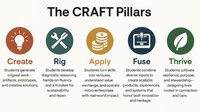One of my favorite strategies in our toolkit at PR With Panache! is Growth-Driven Design (GDD), a relatively new approach to website design and marketing. Developed by HubSpot’s Luke Summerfield, GDD is a powerful way to align the business goals of the C-suite with the work of marketers as they build and improve on their website and marketing efforts.
What Is It?
GDD is an approach to site design that includes measuring the ways users interact with your website. There are three phases: Strategy, Launchpad, and Continuous Improvement. During these phases, you introduce a new feature or asset, measure the ways your users interact with the site before and after that introduction, then make decisions about what changes to make to the website next based on those measurements.
In a traditional approach to designing or overhauling a website, a team will sit down and plan the whole thing out based on best practices and their expert opinions, then build the site itself. They’ll launch it all at once, and only then start measuring its impact. That site will then be expected to do its job for the next three to five years.
When we help clients through the Strategy phase of GDD, on the other hand, we develop a “parking lot list” of things they’d like to include on the website based on business goals. As we implement the highest priority items from the parking lot list during the Launchpad phase, we measure how it changes user interactions and then adjust the priority of the remaining parking lot items during the Continuous Improvement phase..
It’s a very user-focused approach in that we let their behavior inform next steps rather than relying on the opinions and best guesses of marketers or web designers. No matter how good those folks are at their jobs, they just aren’t as good at telling us what users want and how they behave as the users themselves.
A metaphor that helps me explain the value of GDD is to think of the website as an employee. It provides leads for you, educates your customers, and provides customer support, just as employees do. GDD is just a way to provide that employee with ongoing professional development so that it can improve in a job that’s constantly shifting and evolving.
We’ve learned over the last few months as we’ve responded to the pandemic that the website may actually be the only employee who can educate and support customers while also serving as the front door to your entire business.
What’ll It Cost Me?
One of the advantages of GDD is that it’s not necessarily another item in the budget. Since it’s more of a shift in how you approach the website work you’re already doing, it’s really a question of pouring resources into this process instead of a different one.
If you’re looking to get started, HubSpot has a wealth of resources that can help you understand the different stages of the process and documents that walk you steps that include:
- Identifying business goals to work from;
- Conducting an SEO audit of your current site;
- Identifying buyer personas you’re trying to connect with;
- Explaining a range of tools far beyond Google Analytics to help you measure and understand the effects of the changes you implement.
HubSpot tutorials can walk you through building a launchpad website from scratch, or help you figure out how to most easily begin applying GDD to the website you currently have.
When it comes to allocating resources to this process, a dedicated employee committed to holding parking lot items accountable to business goals will help ensure success, but that’s true of any design process. Another potential cost is bringing in an agency like ours to help if you find you need someone with experience in GDD or with some of the more arcane measurement tools.
As with any other investment, the more resources you put into GDD, the more return you’re likely to see, but it’s not any more expensive than other website design processes. And, when you’re doing it right, it will bring in more leads or increase your conversion rate along the way as you implement new improvements.
What Do You Mean, ‘When You’re Doing It Right?’
GDD isn’t perfect, and sometimes businesses fail to get the results they’re after. That’s generally because they haven’t been true to their buyer personas.
I don’t think a lot of folks really put themselves into other people’s shoes and take a hard look at how they might experience something, and that’s no less true when we’re talking about websites or products and services than it is about contentious political topics. That kind of empathy is exactly what GDD tries to help us achieve.
We’re not looking to track all these user decisions to give us numbers that tell us to put a “contact us” link here or a video explainer there. It’s about understanding these users’ actual experiences and finding ways to answer their questions and solve their problems in more human ways.
About the author
Benjamin Bachman is the Marketing Director at PR With Panache. Having built two Gold Marketing HubSpot Agencies from the ground up, Benjamin comes with a wealth of experience in marketing and culture-building. He is also the son of a 40-year veteran of the Pennsylvania public education system. Joining the PRP team has given him a chance to bring strength to an already passionate team, and he couldn't be more excited about PRP's future.











